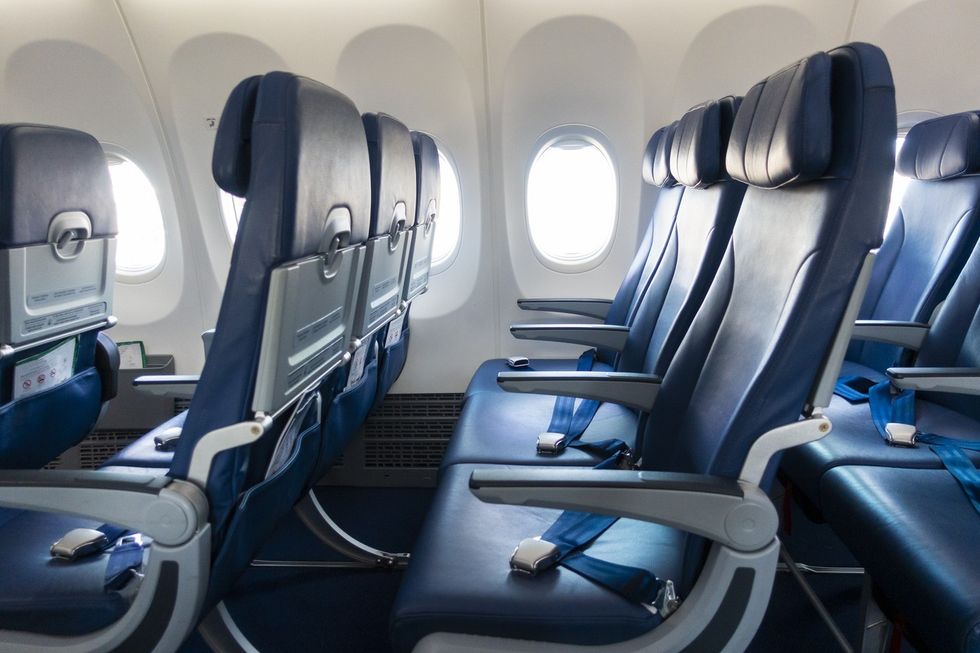If you’re gearing up for a long-haul flight in economy, comfort probably isn’t the first word that comes to mind—but it can be. With international travel by Americans on the rise—outbound trips jumped 4.6% in February 2025 alone—more travelers are packing into tight seats for hours at a time. But here’s the good news: not all economy seats are created equal. And while some airlines are quietly changing legroom, headrests, and seat width in economy, some secret hacks only travel experts know make it possible to survive (and even enjoy) any marathon haul—no matter the airline.
If you have big travel plans this year, read on for expert picks on the most comfortable economy seats in the sky—and how to snag them before they’re gone.
RELATED: 10 Secrets Flight Attendants Will Never Tell You
Study the seat map and know your preferences
tonefotografia/iStock
According to Laura Lindsay, global travel trends expert with Skyscanner, the best place to sit on a plane is subjective and varies according to your individual needs for comfort, convenience, and the nature and duration of your flight.
“Before selecting a seat, consider the following factors: Aircraft type, location, comfort, and window or aisle,” she says. “Familiarize yourself with the seat maps of the aircraft you’ll be flying on, taking note of the layout and available amenities, including things like galleys and lavatories.”
Sit at the front of economy for more leg room

Opting for a bulkhead seat is often the best option for anyone who wants more space and legroom during their flight. Those closer to the front of the plane, even in economy, tend to get other perks, too.
“These seats not only have ultimate flexibility to hop in and out of your seat for the bathroom but are also the first to be serviced for meals,” says Joy Angelica Chan, flight expert with Going. “And without the overhead bin above, there is no fear that items stored above will fall on you.”
That said, there are some drawbacks to sitting in the first row. “You can’t store anything in the space in front of you since all you have is a wall, which means whatever accessible things you need during the flight should be in a size that fits the informational pocket or can be handheld,” Chan says. “Additionally, some luck is involved in choosing these seats as this is where most folks traveling with infants and requiring a bassinet will be seated.”
If bulkheads aren’t available, consider going for another coveted spot onboard. “Exit row seats provide travelers with extra space to stretch out their legs—provided you meet the safety requirements to assist in an emergency,” says Lindsay. Also, some airlines may charge you an additional fee to reserve these seats.
RELATED: United Economy vs. Basic Economy: What Are the Pros and Cons?
Avoid sitting near the engine or noisy areas.

It’s not just about being able to stretch out on long flights. Sometimes, the ability to zone out and avoid distractions from the cabin can be the most valuable thing when you’re spending hours in the air.
“There are two major factors contributing to noise on a plane: engines and high-traffic areas like galleys and bathrooms,” Lindsay says. “Before selecting your seat, it’s helpful to review the seat map to identify their locations and choose your seat accordingly.”
Typically, engines are beneath the wings or at the back of the plane, so look for seats up front where noise levels will be lower.
“On the other hand, if the sound of the engines lulls you to sleep, consider selecting a seat beneath the wings or towards the back,” she adds. “A window seat will also minimize disturbance from aisle traffic.”
Nervous flyers can find a seat that feels calming

Dealing with pre-flight jitters? Where you sit might help you calm any flying anxiety.
“For those worried about turbulence, seats over the wings or at the front of the airplane experience less choppiness,” says Lindsay.
“If confinement is a trigger, aisle seats or those with extra legroom can feel less cramped.”
Finally, “window seats can provide nervous fliers with a sense of security and distraction during takeoff and landings.”
Keep your in-flight plans in mind when selecting your seat

Long plane trips can be an opportunity to get extra work done or catch up on movies and shows you’ve been meaning to watch. Or, you may want to rest—especially if you’re on a red eye.
“If you easily sleep on planes, a window seat provides wall support for dozing off and minimizes disruptions from others in your row,” Lindsay says. “Pro tip: choose a seat on the side you usually sleep on—it makes tilting your head in that direction easier.”
If you plan to stay awake during the flight to watch movies, read, or get work done, aisle seats eliminate the need to climb over sleeping neighbors when you decide to stretch your legs.
Surprisingly, Lindsay also advises considering the center aisle seats on long-haul flights. “It often fills up less and increases your chances of getting a row all to yourself,” she explains.
Hack your seat with travel-friendly accessories.

Of course, there are only so many ideal seats in any airplane cabin. No matter where you’re sitting in economy, you can improve the experience by coming prepared.
“This is basic, but ultimately, bring things that will make you comfortable,” says Chan. “For example, my noise-canceling headphones are a non-negotiable item because you never know what you’ll hear on a flight.”
Other items, like a neck pillow, sleeping mask, or warm socks, can also make you feel cozy throughout your flight.
Another hot tip: Don’t settle for a charging port, television screen, or reclining seat that’s not working.
“If those things aren’t working, don’t be afraid of notifying your flight attendant, who will do whatever they can to fix the issue—or perhaps bump you up into a better and more comfortable seat,” Chan says.
Book your flight early and keep checking the seat map until takeoff.

To lock in your preferred seat, your best bet is to book your flight as early as possible, Lindsay says. But, if that’s not possible, you can still upgrade your seat location at the last minute.
“Keep checking the seat map even after you select your seat,” suggests Chan. “For folks who can choose their seats, there are optimal seats that may open up in the chart that you may want to switch to.”
This can include the aisle seats in the middle row of the plane—where fewer people will climb over you to get up than the aisle seat by the window—or the aisle seat on a three-person window configuration, which has an empty seat in the middle.
Sometimes, you can even score a whole empty row in the back. “It’s a big gamble, but sometimes it pays off,” Chan says.
Once you board, “if you see an empty row, you can notify your flight attendant of your intentions to move there, and they can help you get situated there,” Chan says. “Typically, this move happens once the doors are locked on the ground and sometimes after the flight has reached its cruising altitude.”
Content shared from bestlifeonline.com.

